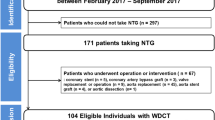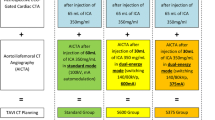Abstract
Purpose
To compare dual-energy computed tomography (DECT) aortography using a 70% reduced iodine dose to single-energy CT (SECT) aortography using a standard iodine dose in the same patient.
Methods
Twenty-one patients with a prior SECT aortography using standard iodine dose had DECT aortography using 70% reduced iodine dose. Section 120 kVp images were compared to DECT images reconstructed at both 50 and 77 keV. Reviewers measured image noise and attenuation in the aorta at eight locations from proximal to distal and subjectively scored vascular enhancement on a four-point scale. Signal-to-noise ratio (SNR) and contrast-to-noise ratio (CNR) were calculated. The volume CT dose index (CTDIvol) for each exam was recorded.
Results
Mean iodine dose was 50 g for SECT and 15 g for DECT (70% reduction). Mean aortic attenuation was similar for section 120 kVp (350 ± 67 HU) and DECT 50 keV (338 ± 57 HU, p = 0.547) but was lower at 77 keV (152 ± 23 HU). Measured image noise was greatest at 50 keV (12 ± 5 HU) and was lowest at 77 keV (7 ± 2 HU, p > 0.001). There was no difference in SNR or CNR between 120 kVp and 50 keV (p > 0.05). Mean subjective vascular enhancement scores for SECT were between good and excellent (3.33–3.69), and for DECT at 50 keV were between moderate and good (2.54–2.93, p < 0.0001). CTDIvol was 13.6 mGy for SECT and 13.1 mGy for DECT (p = 0.637).
Conclusion
70% Reduced iodine DECT aortography may result in similar aortic attenuation, CNR, SNR, and lower although acceptable subjective image scores when compared to standard iodine SECT aortography in the same patient.




Similar content being viewed by others
References
Hagiwara S, Saima S, Negishi K, et al. (2007) High incidence of renal failure in patients with aortic aneurysms. Nephrol Dial Transplant 22:1361–1368
Parmer SS, Fairman RM, Karmacharya J, et al. (2006) A comparison of renal function between open and endovascular aneurysm repair in patients with baseline chronic renal insufficiency. J Vasc Surg 44:706–711
Chang CF, Lin CC (2013) Current concepts of contrast-induced nephropathy: a brief review. J Chin Med Assoc 76:673–681
Laville M, Juillard L (2010) Contrast-induced acute kidney injury: How should at-risk patients be identified and managed? J Nephrol 23:387–398
Nyman U, Almen T, Aspelin P, et al. (2005) Contrast-medium-induced nephropathy correlated to the ratio between dose in gram iodine and estimated GFR in ml/min. Acta Radiol 46:830–842
Schoellnast H, Tillich M, Deutschmann MJ, et al. (2004) Aortoiliac enhancement during computed tomography angiography with reduced contrast material dose and saline solution flush: influence on magnitude and uniformity of the contrast column. Investig Radiol 39:20–26
Shuman WP, Chan KT, Busey JM, Mitsumori LM, Koprowicz KM (2016) Dual-energy CT aortography with 50% reduced iodine dose versus single-energy CT aortography with standard iodine dose. Acad Radiol 23:611–618
Kulkarni NM, Sahani DV, Desai GS, Kalva SP (2012) Indirect computed tomography venography of the lower extremities using single-source dual-energy computed tomography: advantage of low-kiloelectron volt monochromatic images. J Vasc Interv Radiol 23:879–886
Beeres M, Trommer J, Frellesen C, et al. (2016) Evaluation of different keV-settings in dual-energy CT angiography of the aorta using advanced image-based virtual monoenergetic imaging. Int J Cardiovasc Imaging 32:137–144
Pinho DF, Kulkarni NM, Krishnaraj A, Kalva SP, Sahani DV (2013) Initial experience with single-source dual-energy CT abdominal angiography and comparison with single-energy CT angiography: image quality, enhancement, diagnosis and radiation dose. Eur Radiol 23:351–359
Carrascosa P, Capunay C, Rodriguez-Granillo GA, et al. (2014) Substantial iodine volume load reduction in CT angiography with dual-energy imaging: insights from a pilot randomized study. Int J Cardiovasc Imaging 30:1613–1620
He J, Wang Q, Ma X, Sun Z (2015) Dual-energy CT angiography of abdomen with routine concentration contrast agent in comparison with conventional single-energy CT with high concentration contrast agent. Eur J Radiol 84:221–227
Yuan R, Shuman WP, Earls JP, et al. (2012) Reduced iodine load at CT pulmonary angiography with dual-energy monochromatic imaging: comparison with standard CT pulmonary angiography—a prospective randomized trial. Radiology 262:290–297
Godoy MC, Heller SL, Naidich DP, et al. (2009) Dual-energy MDCT: comparison of pulmonary artery enhancement on dedicated CT pulmonary angiography, routine and low contrast volume studies. Eur J Radiol 79:e11–e17
Agrawal MD, Oliveira GR, Kalva SP, Pinho DF, Arellano RS, et al. (2016) Prospective comparison of reduced-iodine-dose virtual monochromatic imaging dataset from dual-energy CT angiography with standard-iodine-dose single-energy CT angiography for abdominal aortic aneurysm. Am J Roentgenol 207:W125–W132
Author information
Authors and Affiliations
Corresponding author
Ethics declarations
Funding
This study was funded by GE Healthcare.
Conflict of interest
William P. Shuman received research grants from GE Healthcare. The other authors declares that he has no conflict of interest.
Ethical approval
All procedures performed in studies involving human participants were in accordance with the ethical standards of the Institutional and/or National Research Committee and with the 1964 Helsinki Declaration and its later amendments or comparable ethical standards.
Informed consent
Informed consent was obtained from all individual participants included in the study.
Rights and permissions
About this article
Cite this article
Shuman, W.P., O’Malley, R.B., Busey, J.M. et al. Prospective comparison of dual-energy CT aortography using 70% reduced iodine dose versus single-energy CT aortography using standard iodine dose in the same patient. Abdom Radiol 42, 759–765 (2017). https://doi.org/10.1007/s00261-016-1041-z
Published:
Issue Date:
DOI: https://doi.org/10.1007/s00261-016-1041-z




